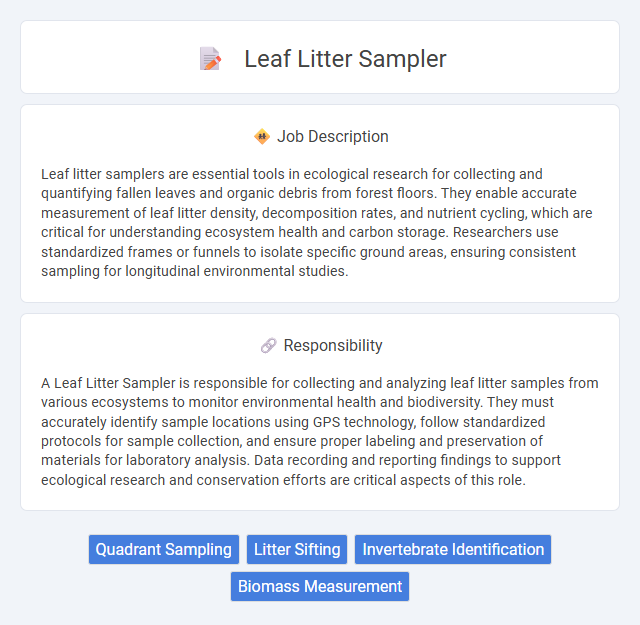
Leaf litter samplers are essential tools in ecological research for collecting and quantifying fallen leaves and organic debris from forest floors. They enable accurate measurement of leaf litter density, decomposition rates, and nutrient cycling, which are critical for understanding ecosystem health and carbon storage. Researchers use standardized frames or funnels to isolate specific ground areas, ensuring consistent sampling for longitudinal environmental studies.
People with a strong interest in environmental science and attention to detail will likely find the Leaf Litter Sampler job suitable, as it involves careful collection and analysis of organic material from forest floors. Those who prefer outdoor work and have good physical stamina may be more inclined to enjoy this role, while individuals who struggle with repetitive tasks or outdoor conditions might find it less fitting. The job may appeal particularly to people who appreciate ecological research and have a patient, methodical approach to fieldwork.
Qualification
Leaf Litter Sampler roles require a strong background in environmental science, ecology, or biology, with practical experience in field data collection and soil analysis techniques. Candidates should possess skills in identifying plant species, operating sampling equipment, and accurately recording environmental variables for ecological research. Proficiency in using GIS tools and data management software enhances the efficiency and accuracy of sampling and reporting processes.
Responsibility
A Leaf Litter Sampler is responsible for collecting and analyzing leaf litter samples from various ecosystems to monitor environmental health and biodiversity. They must accurately identify sample locations using GPS technology, follow standardized protocols for sample collection, and ensure proper labeling and preservation of materials for laboratory analysis. Data recording and reporting findings to support ecological research and conservation efforts are critical aspects of this role.
Benefit
Using a leaf litter sampler likely improves the accuracy and consistency of collecting soil surface organic material, which benefits ecological and environmental studies. This tool probably minimizes contamination and sampling errors, enhancing data reliability for biodiversity assessments and nutrient cycling research. Researchers employing a leaf litter sampler can expect more representative samples, facilitating better-informed conservation strategies.
Challenge
The job of a Leaf Litter Sampler likely involves navigating uneven terrain and dense vegetation, which can present significant physical challenges. There may be a probability of encountering unpredictable weather conditions that complicate data collection. Accurate sampling might also require careful attention to avoid contaminating or missing key components within the leaf litter.
Career Advancement
Leaf Litter Samplers gain valuable experience in ecological data collection, which positions them for progression into environmental research and conservation roles. Mastery in identifying and analyzing organic materials enhances qualifications for specialized fields like forest ecology and biodiversity assessment. Developing technical skills in field sampling and data management opens pathways to leadership opportunities within environmental science organizations.
Key Terms
Quadrant Sampling
Leaf litter sampler plays a crucial role in quadrant sampling by accurately collecting organic material from designated plots to assess ecosystem health and biodiversity. This method involves placing a frame, or quadrant, on the ground and systematically gathering leaf litter within its boundaries to quantify decomposition rates and nutrient cycling. Data obtained from quadrant sampling with leaf litter samplers helps ecologists monitor habitat quality and informs forest management practices.
Litter Sifting
Leaf litter samplers are essential tools for collecting and analyzing forest floor materials, with litter sifting playing a critical role in separating organic debris from soil and small fauna. This method enhances the accuracy of ecological studies by allowing researchers to quantify nutrient cycling and biodiversity within forest ecosystems. Efficient litter sifting improves data quality in studies related to decomposition rates, habitat assessment, and soil health monitoring.
Invertebrate Identification
Leaf litter samplers play a crucial role in ecological studies by collecting organic matter where diverse invertebrate populations thrive. The job involves careful extraction and sorting of leaf litter samples to identify key invertebrate taxa such as mites, springtails, and beetles, which serve as bioindicators of ecosystem health. Precision in morphological identification and use of taxonomic keys ensure accurate assessment of biodiversity and soil quality.
Biomass Measurement
Leaf litter samplers are essential tools for accurately measuring biomass in forest ecosystems by collecting decomposed organic material from the forest floor. These devices quantify leaf litter mass, enabling researchers to estimate nutrient cycling, carbon storage, and ecosystem productivity. Precise biomass measurement using leaf litter samplers supports ecological modeling and forest management practices aimed at sustainability.
 kuljobs.com
kuljobs.com